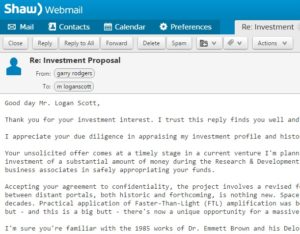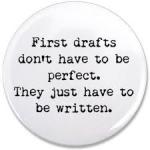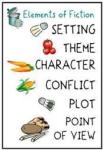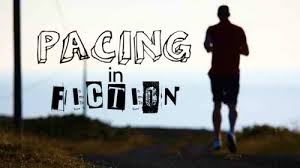 If you don’t know about Nigerian scams then you’ve probably never used the internet. Seems like every couple weeks these West-African crooks drop me an email thinking I’m dumb enough to bite. Some people must or the cons wouldn’t keep trying. So it was no surprise when I checked my inbox Tuesday morning and found another Nigerian grab at my wallet.
If you don’t know about Nigerian scams then you’ve probably never used the internet. Seems like every couple weeks these West-African crooks drop me an email thinking I’m dumb enough to bite. Some people must or the cons wouldn’t keep trying. So it was no surprise when I checked my inbox Tuesday morning and found another Nigerian grab at my wallet.
But it was different this round. For a change, I had little on my plate and time on my hands so I decided to turn the tide on this guy. Here’s what “Mr. Martins Logan Scott” from Nigeria wrote me. Then I’ll show you my reply 🙂
—– Original Message —–
From: “Martins Logan Scott” <voldemars@ngn.lv>
Sent: Tuesday, March 7, 2017 4:24:23 AM
Subject: Investment Proposal
 Attn: Sir — We have gone through your country’s investment profile and history and we are interested to invest in it, we will be willing to partner with you and invest a substantial amount of money in your company if you have an existing company or we can also partner with you to set up a new one, provided you have a substantial and complete feasibility study and a well prepared business plan on the business/company you wil need us to partner with you.
Attn: Sir — We have gone through your country’s investment profile and history and we are interested to invest in it, we will be willing to partner with you and invest a substantial amount of money in your company if you have an existing company or we can also partner with you to set up a new one, provided you have a substantial and complete feasibility study and a well prepared business plan on the business/company you wil need us to partner with you.
Our group is a major player in investment in the middle east, Africa and the United States of America, we believe in pursuing a positive goal, in which your ideas can be enhanced potentially for mutual benefit.
As we seek new frontier and opportunities, we look forward to partner with you. Your prompt reply will be most welcome.
Best regards — Martins Logan Scott — martin.loganscott@gmail.com
—– Original Reply —–
From: “Garry Rodgers” <garry.rodgers@shaw.ca>
Sent: Tuesday, March 7, 2017 7:48:09 AM
Subject: Investment Proposal
Thank you for your investment interest. I trust this reply finds you well and in accordance with the situation.
I appreciate your due diligence in appraising my investment profile and history. That is the primary mark of a careful and prudent investor as I’m sure you and the major players in your group are.
Your unsolicited offer comes at a timely stage in a current venture I’m working on. I was planning to release investment offerings by-invitation-only prior to a NYSE IPO. However, I’m open to prioritizing your group’s investment of a substantial amount of money during my project’s Research & Development (R&D) stage. Therefore, I’d be pleased to accommodate you and your esteemed business associates in safely appropriating your funds.
 With an understanding of your agreement to confidentiality, my project involves a revised form of hyper-velocity, multi-directional transportation. The concept for analogous movement between distant portals, both historic and forthcoming, is nothing new. Space-time dilation based on the Einstein-Rosen bridge theory has been conceptualized for decades. Practical application of Faster-Than-Light (FTL) amplification was bottlenecked due to tachyon condensation which restricted Portal Entrance and Exit (PEE), but there’s now a clear and unique opportunity for a massive breakthrough.
With an understanding of your agreement to confidentiality, my project involves a revised form of hyper-velocity, multi-directional transportation. The concept for analogous movement between distant portals, both historic and forthcoming, is nothing new. Space-time dilation based on the Einstein-Rosen bridge theory has been conceptualized for decades. Practical application of Faster-Than-Light (FTL) amplification was bottlenecked due to tachyon condensation which restricted Portal Entrance and Exit (PEE), but there’s now a clear and unique opportunity for a massive breakthrough.
 I’m sure you’re familiar with the 1985 works of Dr. Emmett Brown and his DeLorean model. Unfortunately, it’s been three decades since Doc vanished in a timely experiment. Although I patiently await his return, progress must move forward. With this, I’ve acquired Doc’s patent rights to the Flux Capacitor (FC) – the propulsion device central to warping the Space-Time Continuum (STC). Early technology restricted FC Input/Output (I/O) to 1.21 jigawatts, however… I’ve found a method of quadrupling I/O to 4.84 jigawatts, theoretically making the trip four times faster.
I’m sure you’re familiar with the 1985 works of Dr. Emmett Brown and his DeLorean model. Unfortunately, it’s been three decades since Doc vanished in a timely experiment. Although I patiently await his return, progress must move forward. With this, I’ve acquired Doc’s patent rights to the Flux Capacitor (FC) – the propulsion device central to warping the Space-Time Continuum (STC). Early technology restricted FC Input/Output (I/O) to 1.21 jigawatts, however… I’ve found a method of quadrupling I/O to 4.84 jigawatts, theoretically making the trip four times faster.
An additional advancement is planned in STC vehicle adaptation. The initial Entry/Reentry Velocity (ERV) difficulties experienced by the DeLorean vehicle proved dangerous. It’s now identified the angular, gull-wing profile created a Disturbance-In-The-Force (DITF). Evolving trials using a rounded VW Beetle prototype was thought to calm FTL/STC/PEE/DITF/ERV vibration – also known as Tolman’s paradox. Quickly, I learned the bulky Punch-Buggie (PB) approach brought no returns and I took a hit.
 Compounding the situation is the original 1.21 jigawatt FC only required an 88 mph ERV. With a four-times capacity 4.84 jigawatt FC, it’s boosted the ERV to 352 mph. I realized… Great Scott! That’s a lot of ground speed. Fortunately, I’ve identified the new Aston Martin AM RB-001 Valkyrie as the perfect design. Now—here’s where you come in.
Compounding the situation is the original 1.21 jigawatt FC only required an 88 mph ERV. With a four-times capacity 4.84 jigawatt FC, it’s boosted the ERV to 352 mph. I realized… Great Scott! That’s a lot of ground speed. Fortunately, I’ve identified the new Aston Martin AM RB-001 Valkyrie as the perfect design. Now—here’s where you come in.
As you know, the Valkyrie is a highly advanced work of technology and produced in 25 unit allotments. I’ve placed an order for one Valkyrie to be refitted as a PEE vehicle, however, the Aston Martin Corporation requires pre-payment in full. With your timely offer of substantial investment capital, in return, I’m offering you the exclusive opportunity to fund my Valkyrie acquisition as the PEE vehicle of choice. It’s noble you believe in pursuing a positive goal and ideas than can be enhanced potentially for our mutual benefit.
 Appreciatively, I’m accepting your group’s investment of $3.12 million USD. This covers the Valkyrie purchase, shipping, and handling. Please make an immediate monetary transfer via Western Union for deposit into my account #6105-883-464-0901 at Nanaimo, British Columbia, Canada. In lieu of cash, your direct purchase of the AM RB-001 PEE Valkyrie can be delivered to my Vancouver Island R&D facility.
Appreciatively, I’m accepting your group’s investment of $3.12 million USD. This covers the Valkyrie purchase, shipping, and handling. Please make an immediate monetary transfer via Western Union for deposit into my account #6105-883-464-0901 at Nanaimo, British Columbia, Canada. In lieu of cash, your direct purchase of the AM RB-001 PEE Valkyrie can be delivered to my Vancouver Island R&D facility.
Thank you for your generous offer, Mr. Logan Scott. Once my project is operational, I confidently assure your investment will be returned to you, along with accrued interest, to any point you prescribe in time. Your prompt reply will be most welcome.
I remain, sir, humbly indebted.
Garry Rodgers





















